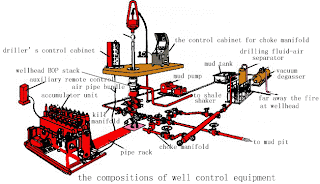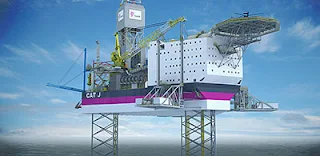If the shell of the ship or offshore rig's pontoon or hull is damaged such as to open one or more
 internal spaces or compartments to the sea, flow will take place between the sea and these spaces until stable equilibrium is established or until the ship sinks or capsizes. The loss of watertight integrity could be due to collision, grounding or internal accident such as an explosion. It is impractical to design a ship to withstand any possible damage. The degree to which a vessel approaches this limit is the true index of its safety. To reduce the probability of loss, the hull is divided into a series of watertight compartments by means of transverse watertight bulkheads extending from side to side of the ship.
internal spaces or compartments to the sea, flow will take place between the sea and these spaces until stable equilibrium is established or until the ship sinks or capsizes. The loss of watertight integrity could be due to collision, grounding or internal accident such as an explosion. It is impractical to design a ship to withstand any possible damage. The degree to which a vessel approaches this limit is the true index of its safety. To reduce the probability of loss, the hull is divided into a series of watertight compartments by means of transverse watertight bulkheads extending from side to side of the ship.
It is true that the more severe the standard adopted for subdivision and stability, the greater the probability that capital and operating costs will be increased. For example, too close spacing of bulkheads may unnecessarily increase both the first cost and operating costs and may also seriously restrict the vessel’s usefulness. In addition, it might be expected that the more bulkheads the safer the ship. But damage may occur entirely between adjacent bulkheads or may involve one or more bulkheads. Hence, for a given length of damage, any increase in the number of bulkheads may actually increase the likelihood of bulkhead damage, which would reduce rather than increase the chances of survival.
The General Effects of Flooding:
The draft will change so that the displacement of the remaining unflooded part of the ship is equal to the displacement of the ship before damage less the weight of any liquids which were in the space opened to the sea.
(2) Change of Trim
The ship will trim until the centre of buoyancy of the remaining unflooded part of the ship lies in a transverse plane through the ship’s or rig's centre of gravity and perpendicular to the equilibrium waterplane.
(3) Heel
If the flooded space is unsymmetrical with respect to the centerline, the ship will heel until the centre of buoyancy of the remaining unflooded part of the ship lies in a fore-and –aft plane through the ship’s centre of gravity and perpendicular to the equilibrium waterline. If the GM in the flooded condition is negative, the flooded ship will be unstable in the upright condition , and even though the flooded space is symmetrical, the ship or semi-sub will either heel until a stable heeled condition is reachedor capsize. Trim and heel may result in further flooding through immersion of openings bulkheads, side shell or decks (downflooding).
(6 ) Loss of Ship or Rig
(4) Change of Stability
Flooding changes both the transverse and longitudinal stability. The initial metacentric height is given by:
GM = KB + BM - KG
Sinkage results in an increase in KB. If there is sufficient trim, there may also be an appreciable further increase in KB as a result. BM tends to decrease because of the loss of the moment of inertia of the flooded part of the waterplane. However, sinkage usually results in an increase in the moment of inertia of the undamaged part of the waterplane, thus tending to compensate for the loss. Also, trim by the stern usually increases the transverse moment of inertia of the undamaged waterplane, and vice versa. For most ocean-going ships the combined effect of these factors is usually a net decrease in GM.
(5) Change of Freeboard
The increase in draft after flooding results in a decrease in the amount of freeboard. Even though the residual GM may be positive, if the freeboard is minimal and the waterline is close to the deck edge, submerging the deck edge at small angles of heel greatly reduces the range of positive righting arm GZ, and leaves the vessel vulnerable to the forces of wind and sea.
(6 ) Loss of Ship or Rig
Where changes in draft, trim and/or heel necessary to attain stable equilibrium are such as to immerse non-watertight portions of a ship, equilibrium will not be reached because of progressive flooding and the ship will sink either with or without capsizing.
Where the maximum GZ in the damaged condition is adequate and where the immersion of non-tight portions of the ship only results in slow extension of flooding, sinking may be quite slow. In such cases, control measures aimed at stopping progressive flooding, either by reducing heel, pumping leakage water or fitting emergency means of checking the flow of water or a combination of such measures may be successful. Therefore, it has been realized that providing the master with an instruction manual outlining damage control measures available to minimize flooding would be a valuable contribution to safety.
Floatation Calculations :
Drillship advantages
Standards for subdivision and damage stability have been established by international conventions, by recommendations of IMO, by national regulations and by classification society rules. In this chapter we shall confine ourselves to the standards related to the International Convention for the Safety of Life at Sea “SOLAS” and the International Convention for the Prevention of Pollution from Ships “MARPOL”.
In order to assess the ship’s or rig's ability to withstand damage, it is necessary to determine:
(a) The damaged waterline, i.e. the new draft, trim and heel.
(b) The damage stability, i.e. after flooding.
The floatation calculations can be carried out by either one of two methods, the lost buoyancy method or the added weight method.
1. The Lost Buoyancy Method
In this method the lost buoyancy due to a compartment or compartments being opened to the sea is calculated. This lost buoyancy and its moments are equated to the buoyancy gain and moments accompanying sinkage, trim and heel of the remaining intact part of the ship. In this method, it is assumed that the displacement and the position of the centre of gravity are unchanged.
This procedure is convenient and simple to use if the form of the vessel and configuration of the flooded space are such that the resulting sinkage, trim and heel do not involve extreme or discontinuous changes in the remaining undamaged part of the waterline. Consequently, this procedure is often used for merchant ships.
Compartments of ship or rig open to the sea do not fill totally with water because some space is already occupied by structure, machinery or cargo. The ratio of the volume which can be occupied by water to the total gross volume is called the permeability μ. For cargo spaces it is taken as 60%, for accommodation spaces as 95% and for machinery spaces as 85%.
The steps of this method are as follows:
1. Calculate the permeable volume of compartment up to the original waterline.
2. Calculate TPC, longitudinal and lateral positions of CF for the waterplane with the damaged area removed.
3. Calculate revised second moments of areas of the waterplane about the CF in the two directions and hence new BMs.
4. Calculate parallel sinkage and rise of CB due to the vertical transfer of buoyancy from the flooded compartment to the layer.
5. Calculate new GMs.
6. Calculate angles of rotation due to the eccentricity of the loss of buoyancy from the new CFs.
Semi-sub advantages
§ motion characteristics suited to most (but not all) ocean
conditions
§ provides a stable platform for drilling and completion
operations
§ Semi-sub disadvantages
§ variable deck load and deck space can be limited
§ relatively slow transit speed
§ may require tow vessels to move (modern DP semis are fully
self-propelled)
§ relatively fast transit
§ most drillship designs can accommodate large loads
of casing,mud chemicals and other supplies in below deck holds
Drillship disadvantages
§ less stable than a semi-sub,
§ less suited for harsh environments
§ Response of the vessel to a given seastate is calculated using
the RAO –
Response Amplitude Operator
§ function of wave height and wave period
§ varies depending on direction of wave (head, beam, quartering)
§ Heave, surge and sway RAO is dimensionless (m/m)
Wave period is key
§ Typical North Sea rough weather, 10-14 second waves
§ drillship heave response is OK compared to semi-sub
§ drillship pitch response worse than semi-sub
§ North Atlantic Storm, 14-19 second waves
Semi-sub pitch and heave response is relatively good, whereas Drillship
pitch and heave response is relatively poor.
Very long ocean swells >19 second period can give the semi
submersible problems as wave period approaches the heave natural frequency.
Such seas can occur in some open ocean areas
§ if heave RAO = 0.3 m/m, then in 10m wave, vessel will heave 3m
§ Pitch, roll and yaw RAO is °/m
§ if pitch RAO = 0.5 °/m, then in 10m wave, vessel
will roll 5°
In deep water and harsh environment/high current location, riser
tensioning capacity may be critical requirement
§ riser analysis essential to determine string configuration and
top tension requirements
§ riser tensioning capacity varies considerably
§ <1 lbs="" million="" to="">5 million lbs
§ A heavy riser string will place considerable demands on the rig
when running BOP
§ string weight in excess of 1.5 million lbs may be required in
some situations
§ riser design may not permit fully buoyant string
§ additional acceleration loads due to rig heave
§ derrick and travelling equipment must be up to the task
Many deepwater rigs (most 6th generation) both semi and ship have some degree of dual activity
capability
§ significant time savings possible in deepwater
§ drill top hole, run surface casing while running BOP
§ in development drilling, can very efficiently install subsea
trees
§ pick up and rack drillpipe, casing offline
§ 20-30% time saving possible, depending on operations
§ can offset day rate premium
§ Best suited to short duration exploration and development
drilling
§ high percentage of open water work
Standards for subdivision and damage stability have been established by international conventions, by recommendations of IMO, by national regulations and by classification society rules. In this chapter we shall confine ourselves to the standards related to the International Convention for the Safety of Life at Sea “SOLAS” and the International Convention for the Prevention of Pollution from Ships “MARPOL”.
The “SOLAS” Standards :
The basic philosophy of these standards is that the true index of safety is the probability of survival after damage occurring anywhere along the length of the ship, between or on a bulkhead.
Fundamentally, three probabilities relate to subdivision and damage stability requirements:
(a) Probability that a ship/rig may be damaged.
(b) If the ship/rig is damaged, the probability as to the location and extent of damage.
(c) Probability that the ship/rig may survive such flooding.
Chapter II-1 of the SOLAS shall apply to ships the keels of which are laid on or after 1 January 2009. These requirements apply to cargo ships of 80 m in length (L) and upwards and to all passenger ships regardless of length. The degree of subdivision shall vary with the subdivision length (Ls) of the ship and with the service, in such manner that the highest degree of subdivision corresponds with the ships of greatest subdivision length (Ls), primarily engaged in the carriage of passengers.
Definitions
1. Subdivision Length (Ls) : The greatest projected length of that part of the ship at or below deck or decks limiting the vertical extent of flooding with the ship at the deepest subdivision draft.
2. Mid-Length : The mid-point of the subdivision length of the ship.
3. Aft and Forward Terminals : The aft and forward limits of the subdivision length.
4. Length (L) : The length as defined in the International Convention on Load lines.
5. Deepest Subdivision Draft (ds) : The waterline which corresponds to the summer load line draft of the ship.
6. Light Service Draft (dl) : The service draft corresponding to the lightest anticipated loading and associated tankage.
7. Partial Subdivision Draft (dp) : The light service draft plus 60% of the difference between the light service draft and the deepest subdivision draft.
8. Permeability (μ) : The permeability of a space is the proportion of the immersed volume of that space which can be occupied by water.
9. Bulkhead Deck : In a passenger ship means the uppermost deck at any point in the subdivision length (Ls) to which the main bulkheads and the ship’s shell are carried watertight. The bulkhead deck may be a stepped deck. In a cargo ship the freeboard deck may be taken as the bulkhead deck.
10. Amidship : At the middle of the length (L).
Permeability :
For the purpose of the subdivision and damage stability calculations of the regulations, the permeability of each general compartment or part of a compartment shall be as follows:
Spaces - "Permeability"
Appropriated to stores 0.60
Occupied by accommodation 0.95
Occupied by machinery 0.85
Void spaces 0.95
Intended for liquids 0 or 0.95
For the purpose of the subdivision and damage stability calculations of the regulations, the permeability of each cargo compartment or part of a compartment shall be as follows:
Spaces -- "Permeability at draft ds" , "Permeability at draft dp" , "Permeability at draft dl"
Dry cargo spaces 0.70, 0.80, 0.95
Container spaces 0.70, 0.80, 0.95
Ro-ro spaces 0.90, 0.90, 0.95
Cargo liquids 0.70, 0.80, 0.95









